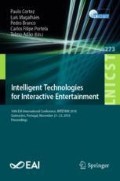Abstract
This paper describes our work in extracting useful cognitive load classification information from a relatively simple and non-invasive physiological measurement technique, with application in a range of Human Factors and Human-Computer Interaction contexts. We employ novel methodologies, including signal processing, machine learning and genetic algorithms, to classify Galvanic Skin Response/Electrodermal Activity (GSR/EDA) signals during performance of a customised game task (UAV Defender) in high- and low-workload conditions. Our results reveal that Support Vector Machine Linear was the most successful technique for classifying the level of cognitive load that an operator is undergoing during easy, medium, and difficult operation conditions. This methodology has the advantage of applicability in critical task situations, where other cognitive load measurement methodologies are problematic due to sampling delay (e.g. questionnaires), or difficulty of implementation (e.g. other psych-physiological measures). A proposed cognitive load classification pipeline for real-time implementation and its use in human factors contexts is discussed.
Access this chapter
Tax calculation will be finalised at checkout
Purchases are for personal use only
References
Ayaz, H., et al.: Cognitive workload assessment of air traffic controllers using optical brain imaging sensors. In: Rice, V. (ed.) Advances in Understanding Human Performance, vol. 20105280, pp. 21–31. CRC Press, Boca Raton (2010)
Baddeley, A.D.: Working memory. Science 255(556–559), 5044 (1992)
Cain, B.: A review of the mental workload literature. Technical report, DTIC (2007). http://oai.dtic.mil/oai/oai?verb=getRecord&metadataPrefix=html&identifier=ADA474193
Cawley, G.C., Talbot, N.L.: On over-fitting in model selection and subsequent selection bias in performance evaluation. J. Mach. Learn. Res. 11(Jul), 2079–2107 (2010)
Dünser, A., Mancero, G.: The use of depth in change detection and multiple object tracking. Ergon. Open J. 2, 142–149 (2009)
Bureau d’Enquetes et d’Analyses France (BEA): Final Report: Accident to Airbus A330–203 Registered F-GZCP, Air France AF 447 Rio de Janeiro - Paris, 1st June 2009. Technical report, Air Accident Investigation Unit (AAIU), October 2014. http://www.aaiu.ie/node/687
Funke, G., et al.: Evaluation of subjective and EEG-based measures of mental workload. In: Stephanidis, C. (ed.) HCI 2013. CCIS, vol. 373, pp. 412–416. Springer, Heidelberg (2013). https://doi.org/10.1007/978-3-642-39473-7_82
Healey, J., Picard, R.: SmartCar: detecting driver stress. In: Proceedings 15th International Conference on Pattern Recognition, ICPR-2000, vol. 4, pp. 218–221 (2000)
Hjorth, B.: EEG analysis based on time domain properties. Electroencephalogr. Clin. Neurophysiol. 29(3), 306–310 (1970)
International Organization for Standardization: ISO 17488:2016(en), Road vehicles - transport information and control systems - detection-response task (DRT) for assessing attentional effects of cognitive load in driving. Technical Report ISO 17488:2016(en), International (2016)
Lim, C.L., et al.: Decomposing skin conductance into tonic and phasic components. Int. J. Psychophysiol. 25(2), 97–109 (1997)
Lochner, M., Duenser, A., Lutzhoft, M., Brooks, B., Rozado, D.: Analysis of maritime team workload and communication dynamics in standard and emergency scenarios. J. Shipp. Trade 3(1), 2 (2018)
Lochner, M.J., Trick, L.M.: Multiple-object tracking while driving: the multiple-vehicle tracking task. Atten. Percept. Psychophys. 76, 2326–2345 (2014)
Nourbakhsh, N., Wang, Y., Chen, F.: GSR and blink features for cognitive load classification. In: Kotzé, P., Marsden, G., Lindgaard, G., Wesson, J., Winckler, M. (eds.) INTERACT 2013. LNCS, vol. 8117, pp. 159–166. Springer, Heidelberg (2013). https://doi.org/10.1007/978-3-642-40483-2_11
Phinyomark, A., Thongpanja, S., Hu, H., Phukpattaranont, P., Limsakul, C.: The usefulness of mean and median frequencies in electromyography analysis. In: Naik, G.R. (ed.) Computational Intelligence in Electromyography Analysis - A Perspective on Current Applications and Future Challenges. INTECH Open Access Publisher (2012). https://doi.org/10.5772/50639
Posada-Quintero, H.F., Chon, K.H.: Frequency-domain electrodermal activity index of sympathetic function. In: 2016 IEEE-EMBS International Conference on Biomedical and Health Informatics (BHI), pp. 497–500, Febraury 2016
Pylyshyn, Z.W., Storm, R.W.: Tracking multiple independent targets: evidence for a parallel tracking mechanism. Spat. Vis. 3(3), 179–197 (1988)
Rozado, D., Duenser, A.: Combining EEG with pupillometry to improve cognitive workload detection. IEEE Comput. 48(10), 18–25 (2015)
Rozado, D., Lochner, M., Engelke, U., Duenser, A.: Detecting intention through motor-imagery-triggered pupil dilations. Hum.-Comput. Inter., 1–31, Febraury 2017
Shi, Y., Ruiz, N., Taib, R., Choi, E., Chen, F.: Galvanic skin response (GSR) as an index of cognitive load. In: CHI 2007 Extended Abstracts, pp. 2651–2656. ACM, New York, April 2007
Uguz, H.: A two-stage feature selection method for text categorization by using information gain, principal component analysis and genetic algorithm. Knowl.-Based Syst. 24(7), 1024–1032 (2011)
Welch, P.: The use of fast Fourier transform for the estimation of power spectra: a method based on time averaging over short, modified periodograms. IEEE Trans. Audio Electroacoust. 15(2), 70–73 (1967)
Wilson, G.F., Fullenkamp, P., Davis, I.: Evoked potential, cardiac, blink, and respiration measures of pilot workload in air-to-ground missions. Aviat. Space Environ. Med. 65(2), 100–105 (1994)
Zhou, J., Sun, J., Chen, F., Wang, Y., Taib, R., Khawaji, A., Li, Z.: Measurable decision making with GSR and pupillary analysis for intelligent user interface. ACM Trans. Comput.-Hum. Interact. 21(6), 1–23 (2015)
Acknowledgements
This research was funded in part by the CSIRO Data61 Automation Trust and Workload CRP, and Australian Research Council DP160101891, CERA247.
Author information
Authors and Affiliations
Corresponding author
Editor information
Editors and Affiliations
Rights and permissions
Copyright information
© 2019 ICST Institute for Computer Sciences, Social Informatics and Telecommunications Engineering
About this paper
Cite this paper
Siriya, S., Lochner, M., Duenser, A., Taib, R. (2019). Exploring Novel Methodology for Classifying Cognitive Workload. In: Cortez, P., Magalhães, L., Branco, P., Portela, C., Adão, T. (eds) Intelligent Technologies for Interactive Entertainment. INTETAIN 2018. Lecture Notes of the Institute for Computer Sciences, Social Informatics and Telecommunications Engineering, vol 273. Springer, Cham. https://doi.org/10.1007/978-3-030-16447-8_11
Download citation
DOI: https://doi.org/10.1007/978-3-030-16447-8_11
Published:
Publisher Name: Springer, Cham
Print ISBN: 978-3-030-16446-1
Online ISBN: 978-3-030-16447-8
eBook Packages: Computer ScienceComputer Science (R0)

